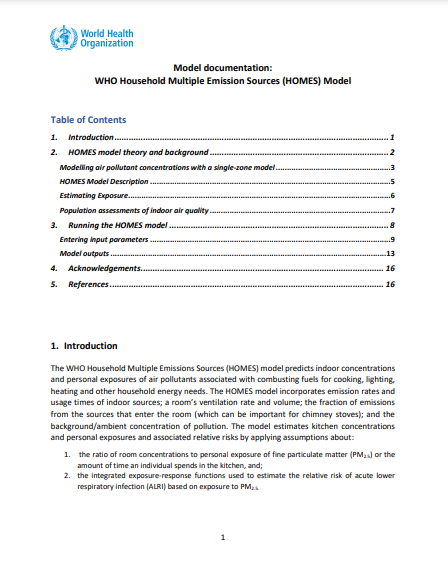Household multiple emission sources (HOMES) model

Overview
The HOMES model incorporates emission rates and usage times of indoor sources; a room’s ventilation rate and volume; the fraction of emissions from the sources that enter the room (which can be important for chimney stoves); and the background/ambient concentration of pollution. The model estimates kitchen concentrations and personal exposures and associated relative risks by applying assumptions about:
1. the ratio of room concentrations to personal exposure of fine particulate matter (PM2.5) or the amount of time an individual spends in the kitchen, and;
2. the integrated exposure-response functions used to estimate the relative risk of acute lower respiratory infection (ALRI) based on exposure to PM2.5. 2 The model is primarily designed for application with PM2.5 and carbon monoxide, as these two pollutants are both commonly emitted by indoor combustion sources and have well-established Air Quality Guidelines (WHO, 2006, 2010, 2014).
The model has been designed to represent the range of environmental and operational conditions expected for the population of interest, by using distributions of input parameters to produce a distribution of predicted indoor air pollution concentrations. This approach, in contrast to using single-point estimates, better represents reality as air pollutant levels in homes also vary.
The model provides a method for users to evaluate the potential implications of various intervention scenarios for a given population or context. Users can input data on up to three different technologies (including traditional or “improved” cookstoves), and the model will output the expected kitchen concentration, personal exposure and level of ALRI relative risk. For example, users can explore what air quality level and exposure would result from a given combination of technical performance and usage, which can be helpful for program planning. The results can help inform which technologies are recommended for programmatic interventions and the degree to which traditional technologies need to be displaced. Should data on emissions performance, stove usage, and environmental conditions (ventilation and kitchen volumes) be available for intervention or program, the impacts on kitchen concentrations and personal exposures can also be modelled using HOMES. Importantly, the model is only intended to illustrate potential air quality and exposure scenarios; it does not replace field assessments.
The HOMES model is forward-looking in estimating kitchen concentrations and exposures resulting from up to three emissions sources. To derive specific emissions performance which would result in meeting air quality targets, the complimentary WHO Performance Target (PT) model should be used. The PT model was developed to help guide the establishment of emissions performance targets, whereas the HOMES model is designed to explore how different combinations of performance from multiple sources may affect potential kitchen concentrations and personal exposures. This document explains the theoretical underpinnings of the model and the background for its development and serves as a guide to running the web-based model.
